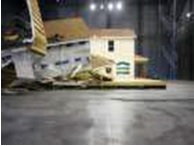A PICTURE MUCH LARGER THAN WHAT MOST WOULD BELIEVE – by Lewis O’leary
On July 9, 2017 the News & Observer (N&O), a Raleigh, NC based newspaper, published a front page article entitled “Nearly 200,000 N. C. homes at risk from tropical winds”. It explains that nearly all “manufactured” (aka mobile) homes will go to pieces if they are exposed to a “strong” Hurricane. In an attempt to quantify this, I turned to the “Enhanced Fujita Scale” which sets out 28 tables that describe what the “Degree of Damage” would normally be associated with ever increasing wind speeds for different objects. Table 4 is for a “doublewides” which shows that older manufactured homes, will suffer “Complete destruction of roof and walls leaving undercarriage in place” at or about 93 mph, 3-second gusts. Because meteorologist report hurricane wind speeds in terms of “sustained” (aka 1-minute sustained) units of measure, one would need to multiple the “sustained” values times 1.3 to get to the 3-second gust unit of measure. This is necessary to get the unit of measure that design engineers use. This means that the older manufactured homes would be destroyed at or about 72 mph, 1- minute sustained wind speed. This is actually below the threshold value for a Category 1 Hurricane. The surprising part here is that the newer manufactured homes are also affected. These with suffer catastrophic damage at or about 85 mph, “sustained” values, which is only a mid-range, category 1 hurricane. Admittedly the topography plays a role in reducing the “free stream” velocity but, if the winds are increased to a midrange Category 2 the wind speed reduction as the result of the ground clutter will still be at or around this 85 mph, “1-minute sustained” wind speed.
What is only known by the most seasoned of investigators is that the problem of unsafe housing is far bigger than just manufactured homes. Winds in this same speed range will also create significant, wide-spread damages to both older homes and commercial buildings. Despite knowledge of this, very few investigators can identify the more subtle but significant reasons why widespread, new leaks have begun. This is especially true for when it comes to roofs.
The N&O was provided with the aforementioned data by “The Insurance Institute for Business and Home Safety”. The industry took notice after Hurricane Andrew (1992) that structures of all kinds sustained damages beyond what the “Fujita Scale” had forecasted in 1971. Texas Tech’s Wind Science and Engineering Center had been studying the disparity between what structures were supposed to handle, versus what they could actually handle in high wind events, long before Hurricane Andrew. In 2003 they published their findings in a vastly improved version of “The Fujita Scale”, and called it the “Enhanced Fujita Scale”.

The Enhanced Fujita Scale shows that older structures are only good for about half the wind force that they were supposedly designed for. To test this theory, in 2010 the same “Insurance Institute for Business and Home Safety” built 3 cosmetically identical pairs of homes in a wind tunnel and conducted 3 separate tests. In each case, one of the homes was built to the latest design guidelines, while the other was built to a much earlier code. The wind speed was steadily increased and in each of the 3 tests, the older code homes were destroyed before the new codes homes reached the threshold for visible damages.

The question of what caused damages beyond what a structure should have withstood comes up with each severe wind event. This is especially true for roofs. Commonly, when an older, but still very functional roof suddenly develops widespread leaks, the “average” investigator will find no “obvious” evidence. There are 2 reasons for this. One, latent evidence is difficult to find if you are not looking for it. Second, the average investigator does not have the training to know what to look for. As such, he will commonly assign the leaks to wear & tear, defective design or workmanship as the causation of the widespread leaks. There is a distinct lack of training materials that specifically addresses and set out a protocol for identifying “latent” wind damages.
In my experience, starting with Hurricane Camille (1969), it is common for investigators to only identify about half of the total storm damages. Even fewer know how to assess whether the damages are old or new.
________________________________________________________________________________________________

Lewis O’Leary has served as both a forensic investigator and restoration contractor since Hurricane Camille (1969). He has a degree in the fields of Mechanical Engineering and Architecture, is the Chairman of the Education Committee for the Building Envelope Science Institute and is a design/build, General Contractor licensed in North Carolina. He also serves as a staff consultant for engineering firms involved with wind damages from hurricanes and tornadoes. He can be contacted at 919-577-0907 or via e-mail at probuil@aol.com




